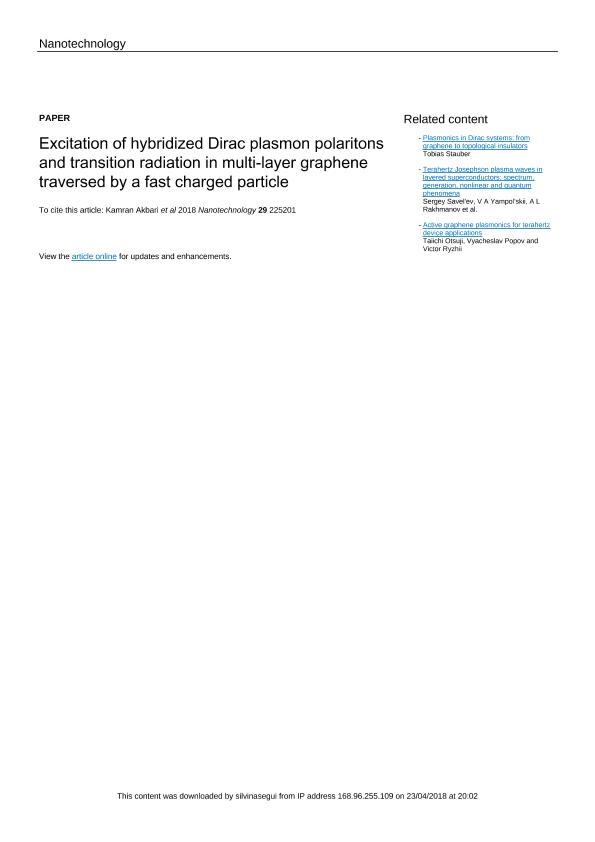Artículo
Excitation of hybridized Dirac plasmon polaritons and transition radiation in multi-layer graphene traversed by a fast charged particle
Akbari, Kamran; Mišković, Zoran L.; Segui Osorio, Silvina Inda Maria ; Gervasoni, Juana Luisa
; Gervasoni, Juana Luisa ; Arista, Néstor R.
; Arista, Néstor R.
 ; Gervasoni, Juana Luisa
; Gervasoni, Juana Luisa ; Arista, Néstor R.
; Arista, Néstor R.
Fecha de publicación:
29/03/2018
Editorial:
IOP Publishing
Revista:
Nanotechnology
ISSN:
0957-4484
Idioma:
Inglés
Tipo de recurso:
Artículo publicado
Clasificación temática:
Resumen
We analyze the energy loss channels for a fast charged particle traversing a multi-layer graphene (MLG) structure with N layers under normal incidence. Focusing on a terahertz (THz) range of frequencies, and assuming equally doped graphene layers with a large enough separation d between them to neglect interlayer electron hopping, we use the Drude model for two-dimensional conductivity of each layer to describe hybridization of graphene's Dirac plasmon polaritons (DPPs). Performing a layer decomposition of ohmic energy losses, which include excitation of hybridized DPPs (HDPPs), we have found for N = 3 that the middle HDPP eigenfrequency is not excited in the middle layer due to symmetry constraint, whereas the excitation of the lowest HDPP eigenfrequency produces a Fano resonance in the graphene layer that is first traversed by the charged particle. While the angular distribution of transition radiation emitted in the far field region also shows asymmetry with respect to the traversal order by the incident charged particle at supra-THz frequencies, the integrated radiative energy loss is surprisingly independent of both d and N for N ≤ 5, which is explained by a dominant role of the outer graphene layers in transition radiation. We have further found that the integrated ohmic energy loss in optically thin MLG scales as ∝1/N at sub-THz frequencies, which is explained by exposing the role of dissipative processes in graphene at low frequencies. Finally, prominent peaks are observed at supra-THz frequencies in the integrated ohmic energy loss for MLG structures that are not optically thin. The magnitude of those peaks is found to scale with N for N ≥ 2, while their shape and position replicate the peak in a double-layer graphene (N = 2), which is explained by arguing that plasmon hybridization in such MLG structures is dominated by electromagnetic interaction between the nearest-neighbor graphene layers.
Palabras clave:
ELECTRON BEAM
,
ENERGY LOSS
,
GRAPHEME
,
PLASMON
,
TRANSITION RADIATION
Archivos asociados
Licencia
Identificadores
Colecciones
Articulos(CCT - PATAGONIA NORTE)
Articulos de CTRO.CIENTIFICO TECNOL.CONICET - PATAGONIA NORTE
Articulos de CTRO.CIENTIFICO TECNOL.CONICET - PATAGONIA NORTE
Citación
Akbari, Kamran; Mišković, Zoran L.; Segui Osorio, Silvina Inda Maria; Gervasoni, Juana Luisa; Arista, Néstor R.; Excitation of hybridized Dirac plasmon polaritons and transition radiation in multi-layer graphene traversed by a fast charged particle; IOP Publishing; Nanotechnology; 29; 22; 29-3-2018; 1-14
Compartir
Altmétricas



